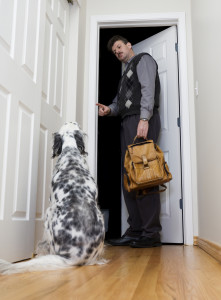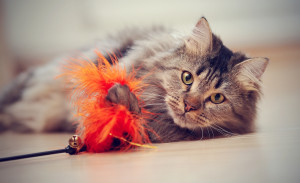Back-to-school conversations aren’t just about kids. Your beloved pets have adjustments to make too. Constant companionship, unlimited attention, extended playtimes and the comfort of having loved ones around are things that most pets crave. During the summer months, your fur buddies grow accustomed to frolicking in the sunshine with their human siblings, running errands with the family or just taking lazy afternoon naps after a nice long belly-rub. With the kids heading back to school shortly, days like this will likely come to an abrupt end and be replaced with the early morning scramble followed by long periods of solitude, causing your pet to easily grow restless and bored.

While cats may be affected, this time of year can be particularly stressful for dogs. And we all know that pets sometimes express their emotional dissatisfaction by engaging in unwanted behaviors. Fortunately, we have a few ideas to help make the back-to-school transition a low-stress event for your pet and the entire family.
Practice Makes Perfect
Establish and practice a few “I’m leaving” routines with your kids and your pet without any of you actually going anywhere. For example, gather your keys and other belongings while opening the front door, but do not actually leave. Focus on getting your pet accustomed to these triggers without following through with the undesired departure. By allowing them to get comfortable with these cues, your pets will not be as anxious each time they’re encountered as the kids head back to school.
It’s also a good idea to practice leaving your dog or cat alone at home for short intervals. Start with small blocks of time, like 15 minutes or so, and gradually work your way up to longer periods. When you’ve got a quick errand to run, don’t take her with you no matter how excited she gets at the jingling sound of your keys or how moved you are by the forlorn look in her eyes. Doing this for a few weeks will help her understand that there are times when she will be alone, but that she is not being abandoned– the family will return!
Skip the Fanfare
When departing and returning, do so without allowing either to become a major production. Politely tell her goodbye and do not engage in hugging or petting at this time. Too much fanfare will only make her more anxious after you are gone.
Upon returning, try not to immediately offer your pet an enthusiastic greeting. Instead, teach her to be calm by remaining calm yourself and only engage with her after she has entered a more relaxed state. By consistently doing this, you are teaching your fur-baby that leaving and returning are perfectly normal routines in your household and not something that she needs to get too anxious or excited about.

Teach Your Pet That Space Is a Good Thing
While it is nice to have a constant companion, your pets should also understand that a little space is good. Helping them develop this understanding will go a long way in alleviating their back-to-school discomfort. Dogs are particularly fond of following family members wherever they may go and while some cats enjoy the same closeness, most also enjoy their own space from time to time, so we’ll direct this tip primarily to your pooch.
Teach your dog to give you a little distance, even while in the same room, by discouraging her from constantly being at a family member’s heels or by someone’s side. All of you should be able to comfortably walk from room to room, shower or enjoy a television show without your faithful companion in your shadow during every one of these activities.
Practicing close physical separation while everyone is in the home may help your pet more easily adjust to back-to-school routines and learn a sense of independence at the same time. Small dogs who are used to being held and carried may have a particularly rough time with weaning from physical separation. For these pooches, start with small 5 minute intervals of separation while in the same room and work your way up to longer times until she learns that it is okay for everyone to move about separately while under the same roof. Consider using play toys to distract them from their separation anxiety.
Big Meals and Long Walks
A morning rush period followed by a long lonely day can feel overwhelming to a pet who does not understand what is happening and who is not used to daily solitude. One way to make the back-to-school transition easier is to tire your pet out early through exercise and feeding. Practice waking the family up a little earlier just to take your dog on a long walk so that she can expend as much energy as possible. Follow that long walk up with a heavy meal and your pooch just might be ready for dreamland by the time you and the kids close the door behind you each morning.
Provide Energy Outlets
Even if you’re successful in tiring your pet out with a long walk and a heavy meal, that state won’t carry her through the entire day. And since cats don’t typically take long walks, you’re going to have to be creative in occupying them throughout the day, too. Pent up energy can easily overwhelm an animal and you may come home to a few unwelcoming surprises, as a result. To offer your cuddle buddy a few energy outlets, try these tips:
- Place a perch near a window so that kitty can observe the outside world between naps
- Hide a few snacks around the house to let your pet hunt and catch her treats
- Place a few snacks inside a safe plastic bottle or a specially designed toy, such as a Kong, so that your fur baby has to work to get the goodies out
- Leave special “home alone” toys around the house so that your curious little friend will find them as she roams (when you are home, keep these toys out of reach so that they are only associated with this activity)

Teach Children the Importance Of Routines
When heading back-to-school, the entire family will need to adjust to new routines, including new pet schedules. Make certain that young children understand the importance of helping cats and dogs acclimate to new feeding, walking and play schedules. Creatures of habits that they are, four-legged kids may become confused if these times and activities are not adhered to on a consistent basis and such could make the transition a more stressful time for the entire family.
One specific routine that children can help with in a big way is to spend 30 minutes or so playing with the family pet upon returning home (after she has calmed down from the initial greeting, of course). Making a specific toy available only for this time of play is a good idea. Not only will it allow your pet time to briefly reconnect with the kids, but your children can probably appreciate a little unwind time before homework as well. Just be sure to help kids regulate this play schedule until it becomes a daily after school activity.
Long Walks Go a Long Way
At the end of the day, take your dog for another long walk. This one isn’t just to burn residual energy, but also as a calming practice during which time you can reward her for braving so many hours alone. For cats, substitute this time with energetic play, cat toy chasing and lots of cuddling. Like everything else, this activity should be at the same time each day. With consistency, your pet just may discover that this new back-to-school routine has a few perks and that a little separation isn’t so bad after all.
Practice Patience
Despite how you might prepare your four-legged buddy for the transition, expect a little acting out while she is learning how to be alone. Be patient and understand that the emotional experience of separation is a very real one for her. Her boredom might cause her to do things she’s never done before, such as shredding the toilet paper in your bathroom, relieving herself in your shoes or barking incessantly. You may think that she carefully plotted these activities to take revenge against you for leaving her alone, but really she’s just frustrated, bored and has pent up energy that needs to be burned off.
Consider your pet’s nature when adjusting to back-to-school routines, too. For example, dogs are particularly social animals and they don’t always do well with long periods of solitude until trained to do so. Puppies will especially struggle with this adjustment, particularly if they entered the family during the summer months when plenty of attention was freely given to them.
With this in mind, never scold your pet when returning home to a mess and do not expect her to understand what she has done to upset you. Instead, continue to practice the tips offered above and be patient with her during this adjustment period. Should undesirable behaviors last well into the school year, contact a trainer who specializes in anxiety issues and work with your cherished one until things improve. You might also consider enlisting one of our professional pet sitters or dog walkers to visit your pet daily while you’re away to give your pet the exercise, stimulation and attention they crave.
Recognize Your Pet’s Limits
Remember that these tips are only for school days. If you are leaving home for the weekend or even just for an overnight visit, it’s best to let one of our sitters help out with your furry friend until you return. Animals need care and attention and while learning how to spend a day alone is a good thing, don’t ever force your pet to endure more time alone than she can confidently handle.
We Want To Hear From You
This post isn’t finished until we read your best tips for helping a pet get over the back-to-school blues. What are some ideas you’ve tried in the past and how have they worked for you? Do you have a specific question about pets and the adjustments they have to make when kids head back to school? The comments section is officially open and we are looking forward to reading your words of wisdom…
Source: Read Full Article



